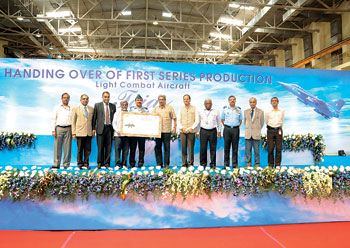INDIAN ARMED FORCES CHIEFS ON OUR RELENTLESS AND FOCUSED PUBLISHING EFFORTS

The insightful articles, inspiring narrations and analytical perspectives presented by the Editorial Team, establish an alluring connect with the reader. My compliments and best wishes to SP Guide Publications.

"Over the past 60 years, the growth of SP Guide Publications has mirrored the rising stature of Indian Navy. Its well-researched and informative magazines on Defence and Aerospace sector have served to shape an educated opinion of our military personnel, policy makers and the public alike. I wish SP's Publication team continued success, fair winds and following seas in all future endeavour!"

Since, its inception in 1964, SP Guide Publications has consistently demonstrated commitment to high-quality journalism in the aerospace and defence sectors, earning a well-deserved reputation as Asia's largest media house in this domain. I wish SP Guide Publications continued success in its pursuit of excellence.
- Indian Air Force Aims for Full Indigenous Inventory by 2047 — Air Chief Marshal A.P. Singh
- General Upendra Dwivedi takes over as the Chief of the Army Staff
- Rajnath Singh assumes charge as Defence Minister for the second consecutive term
- Admiral Dinesh K. Tripathi assumes Command of the Indian Navy as 26th Chief of the Naval Staff
- Prime Minister witnesses 'Bharat Shakti' – a Tri-Services Firing and Manoeuvre Exercise in Pokhran, Rajasthan
Defence Minister hands over Tejas to Indian Air Force

Defence Minister Manohar Parrikar handed over the first series production light combat aircraft (LCA) Tejas made by the Hindustan Aeronautics Limited (HAL) to the Indian Air Force (IAF) at a ceremony at HAL Bengaluru complex on January 17, 2015. The Air Chief Marshal Arup Raha, Chief of the Air Staff (CAS), received the aircraft documents from the Minister in presence of HAL Chairman Dr R.K. Tyagi.
Speaking at the ceremony, Defence Minister congratulated HAL and everyone involved in the project and called upon to think “out of the box” to meet the time line challenges by applying the right management tools. “Thrust should be given on research and technology by exploiting the existing knowledge base which companies like HAL have”, he said. “Although one does not achieve everything overnight. However by modifying our work culture and by adopting better technology and tools we can achieve the results better”, he added.
The CAS outlined that LCA is the need of the hour, given the operational needs of IAF. “We are happy to receive the documents of the first series production of LCA”, he said. He complimented HAL for handing over this aircraft, which would allow its induction and subsequent formation of first Tejas squadron.
Dr Tyagi described the event as one of the major milestones in the history of HAL. “We have achieved 60 per cent indigenisation in this LCA project so far. We will produce six aircraft next year (2015-16) and subsequently scale it up to eight and 16 aircraft per year” he added. He complimented, IAF, the Aeronautical Development Agency, Centre for Military Airworthiness & Certification, Directorate General of Aeronautical Quality Assurance, National Aerospace Laboratory and other participating institutions for the successful delivery of first series production aircraft.
Tejas is a 4.5th generation aircraft. It is significant for its lighter weight and greater agility and manoeuvrability. The lighter weight is achieved by use of higher percentage of carbon fibre composites. Other significant features of this indigenous aircraft are the digital fly-by-wire system, flight control systems, open architecture computer, etc. The naval variant of LCA is also under development and had last month did its first flight from the shore-based test facility (STBF) at Goa.
In the design and development programme, HAL has produced 15 aircraft including the seven in limited series production (LSP), two technology demonstrators, three fighter prototype, two trainer prototype and one naval prototype. These aircraft have completed more than 2,800 flights.
With the coming up of new high-tech manufacturing complex for the capacity augmentation of LCA, HAL is confident of sharing its responsibility in ensuring the national security. HAL is the principal partner for the development of LCA along with the Aeronautical Development Agency which is the nodal design agency and responsible for programme management of the project.





